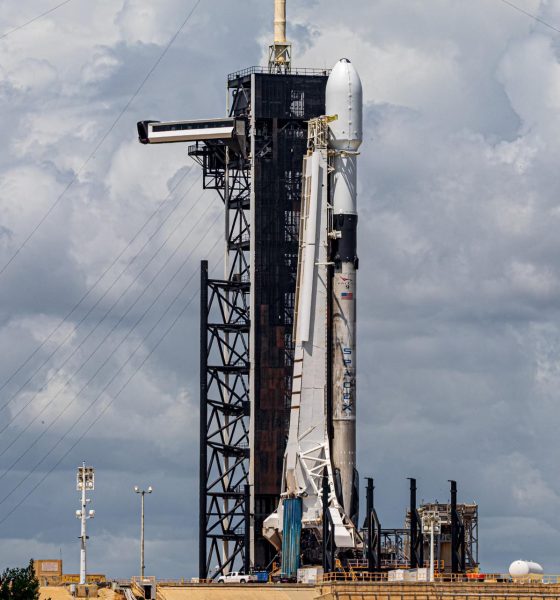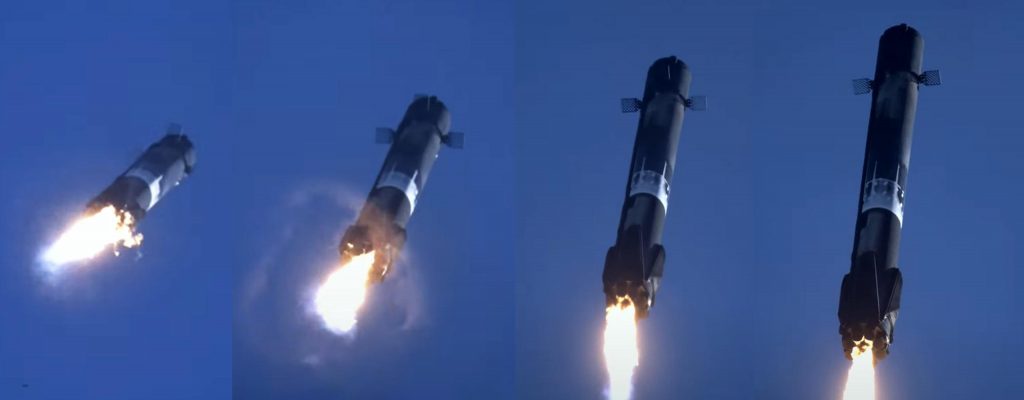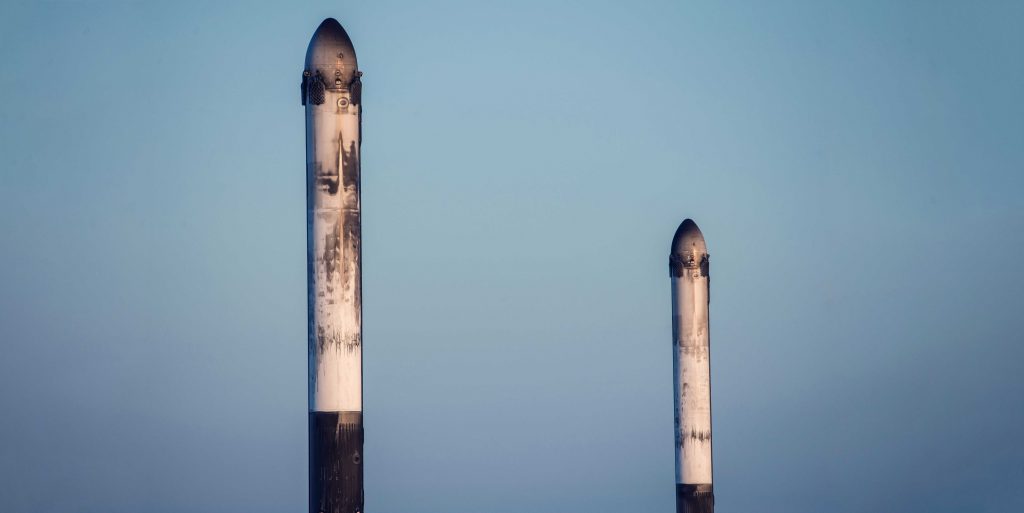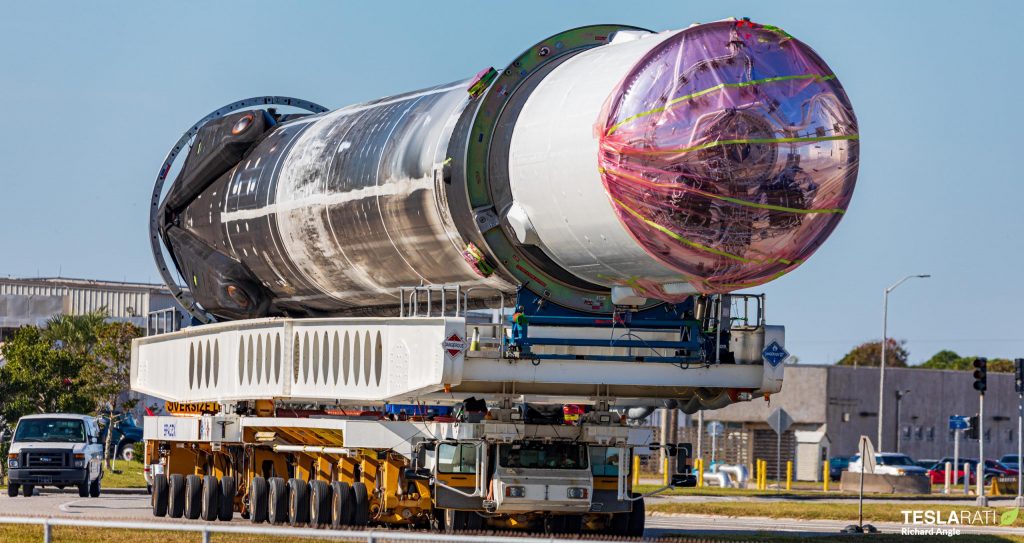

News
SpaceX readies 4th Falcon 9 booster for 10th launch and landing [webcast]
Update: SpaceX has delayed Starlink 4-6 and Falcon 9 B1060’s tenth launch and landing to a backup window scheduled no earlier than (NET) 9:02 pm EST, Tuesday, January 18th (02:04 UTC 19 Jan).
Initially aiming for January 17th, SpaceX pushed the mission to 7:04 pm EST, January 18th for “more favorable weather conditions for liftoff and booster recovery.” A backup window two hours later on the same day was likely selected for similar reasons. Tune in around 8:45 pm EST (01:45 UTC) to watch Falcon 9 B1060’s tenth launch and landing attempt live.
Four days after Falcon 9 B1058 became the third SpaceX booster to complete ten orbital-class launches, the company is set to repeat the feat a fourth time.
Unofficially revealed by airspace and maritime safety alerts on January 12th, SpaceX has confirmed plans to launch Starlink 4-6 – another batch of 49 laser-linked V1.5 satellites – no earlier than (NET) 7:26 pm EST, Monday, January 17th (00:26 UTC 18 Jan) from Kennedy Space Center Pad 39A. The same pad supported an identical launch (Starlink 4-5) on January 6th, requiring a brisk 11-day turnaround for a pad that’s all-time record is two Falcon launches in 10 days.
While technically “just” another Starlink launch, the mission will mark the first time two Falcon 9 boosters have launched for the tenth time back to back. On January 13th, Falcon 9 B1058 helped deliver 105 small rideshare satellites to orbit, completing its tenth successful launch and landing in the process. While there are only two other ten-flight boosters to compare against, B1058 crossed the milestone more than a third faster than either of its siblings, launching ten times in 19 months or once every ~59 days for the duration of its life.

When Falcon 9 B1060 lifts off with Starlink 4-6 on January 17th, 2022, it will do so in 18 months (~81 weeks), beating B1058’s days-old record (19 months or ~85 weeks) by about a month. Though there are several younger, less-flown boosters in SpaceX’s current Falcon fleet, none of them appear to be on track to more than marginally beat or match the records about to be set by B1058 and B1060. Based on SpaceX’s twice-achieved 27-day Falcon 9 turnaround record, it might technically be possible for the same booster to complete 10 launches in as few as 270 days (~39 weeks), employees have described those record turnarounds as “a mad rush” – probably not a sustainable pace for the current workforce, in other words.
Nonetheless, even if evidence continues to grow that the current iteration of Falcon Block 5 boosters are unlikely to average more than one launch every 50-60 days over their lives, SpaceX could still theoretically achieve an eyewatering launch cadence. For example, if SpaceX’s current fleet of nine operational Falcon boosters (including one converted Falcon Heavy core) can each achieve an average of one launch every 60 days starting now, SpaceX could feasibly launch more than once per week or ~54 times per year. If SpaceX also converts Falcon Heavy core B1053 into a Falcon 9, damaged Falcon 9 booster B1069 is able to enter the fleet, and the average turnaround time drops to 50 days, that 11-booster fleet could support up to 80 launches per year.


SpaceX’s three Falcon launch pads could theoretically support up to 90 launches per year if every single turnaround was as fast as each pad’s all-time record and no extended downtime was ever needed. In other words, in spite of just how far the Falcon Block 5 design appears to be from CEO Elon Musk’s long-stated dream of daily reuse, a fleet of just 15 Block 5 boosters averaging a conservative 60 days per launch could achieve an annual cadence that would force SpaceX to upgrade its launch pads to go any higher.
With Starship on the horizon, though, it’s no longer clear that SpaceX actually wants to push the Falcon family’s envelope to the point that another round of significant vehicle or pad upgrades are required. Unless Starship suffers catastrophic setbacks causing years of delays, it’s more likely than not that the Falcon family will peak around 60 launches per year (still incredibly impressive) before its likely retirement.

Elon Musk
Elon Musk’s X will start using a Tesla-like software update strategy
The initiative seems designed to accelerate updates to the social media platform, while maintaining maximum transparency.

Elon Musk’s social media platform X will adopt a Tesla-esque approach to software updates for its algorithm.
The initiative seems designed to accelerate updates to the social media platform, while maintaining maximum transparency.
X’s updates to its updates
As per Musk in a post on X, the social media company will be making a new algorithm to determine what organic and advertising posts are recommended to users. These updates would then be repeated every four weeks.
“We will make the new 𝕏 algorithm, including all code used to determine what organic and advertising posts are recommended to users, open source in 7 days. This will be repeated every 4 weeks, with comprehensive developer notes, to help you understand what changed,” Musk wrote in his post.
The initiative somewhat mirrors Tesla’s over-the-air update model, where vehicle software is regularly refined and pushed to users with detailed release notes. This should allow users to better understand the details of X’s every update and foster a healthy feedback loop for the social media platform.
xAI and X
X, formerly Twitter, has been acquired by Elon Musk’s artificial intelligence startup, xAI last year. Since then, xAI has seen a rapid rise in valuation. Following the company’s the company’s upsized $20 billion Series E funding round, estimates now suggest that xAI is worth tens about $230 to $235 billion. That’s several times larger than Tesla when Elon Musk received his controversial 2018 CEO Performance Award.
As per xAI, the Series E funding round attracted a diverse group of investors, including Valor Equity Partners, Stepstone Group, Fidelity Management & Research Company, Qatar Investment Authority, MGX, and Baron Capital Group, among others. Strategic partners NVIDIA and Cisco Investments also continued support for building the world’s largest GPU clusters.
News
Tesla FSD Supervised wins MotorTrend’s Best Driver Assistance Award
The decision marks a notable reversal for the publication from prior years, with judges citing major real-world improvements that pushed Tesla’s latest FSD software ahead of every competing ADAS system.

Tesla’s Full Self-Driving (Supervised) system has been named the best driver-assistance technology on the market, earning top honors at the 2026 MotorTrend Best Tech Awards.
The decision marks a notable reversal for the publication from prior years, with judges citing major real-world improvements that pushed Tesla’s latest FSD software ahead of every competing ADAS system. And it wasn’t even close.
MotorTrend reverses course
MotorTrend awarded Tesla FSD (Supervised) its 2026 Best Tech Driver Assistance title after extensive testing of the latest v14 software. The publication acknowledged that it had previously criticized earlier versions of FSD for erratic behavior and near-miss incidents, ultimately favoring rivals such as GM’s Super Cruise in earlier evaluations.
According to MotorTrend, the newest iteration of FSD resolved many of those shortcomings. Testers said v14 showed far smoother behavior in complex urban scenarios, including unprotected left turns, traffic circles, emergency vehicles, and dense city streets. While the system still requires constant driver supervision, judges concluded that no other advanced driver-assistance system currently matches its breadth of capability.
Unlike rival systems that rely on combinations of cameras, radar, lidar, and mapped highways, Tesla’s FSD operates using a camera-only approach and is capable of driving on city streets, rural roads, and freeways. MotorTrend stated that pure utility, the ability to handle nearly all road types, ultimately separated FSD from competitors like Ford BlueCruise, GM Super Cruise, and BMW’s Highway Assistant.
High cost and high capability
MotorTrend also addressed FSD’s pricing, which remains significantly higher than rival systems. Tesla currently charges $8,000 for a one-time purchase or $99 per month for a subscription, compared with far lower upfront and subscription costs from other automakers. The publication noted that the premium is justified given FSD’s unmatched scope and continuous software evolution.
Safety remained a central focus of the evaluation. While testers reported collision-free operation over thousands of miles, they noted ongoing concerns around FSD’s configurable driving modes, including options that allow aggressive driving and speeds beyond posted limits. MotorTrend emphasized that, like all Level 2 systems, FSD still depends on a fully attentive human driver at all times.
Despite those caveats, the publication concluded that Tesla’s rapid software progress fundamentally reshaped the competitive landscape. For drivers seeking the most capable hands-on driver-assistance system available today, MotorTrend concluded Tesla FSD (Supervised) now stands alone at the top.
News
Elon Musk’s Grokipedia surges to 5.6M articles, almost 79% of English Wikipedia
The explosive growth marks a major milestone for the AI-powered online encyclopedia, which was launched by Elon Musk’s xAI just months ago.

Elon Musk’s Grokipedia has grown to an impressive 5,615,201 articles as of today, closing in on 79% of the English Wikipedia’s current total of 7,119,376 articles.
The explosive growth marks a major milestone for the AI-powered online encyclopedia, which was launched by Elon Musk’s xAI just months ago. Needless to say, it would only be a matter of time before Grokipedia exceeds English Wikipedia in sheer volume.
Grokipedia’s rapid growth
xAI’s vision for Grokipedia emphasizes neutrality, while Grok’s reasoning capabilities allow for fast drafting and fact-checking. When Elon Musk announced the initiative in late September 2025, he noted that Grokipedia would be an improvement to Wikipedia because it would be designed to avoid bias.
At the time, Musk noted that Grokipedia “is a necessary step towards the xAI goal of understanding the Universe.”
Grokipedia was launched in late October, and while xAI was careful to list it only as Version 0.1 at the time, the online encyclopedia immediately earned praise. Wikipedia co-founder Larry Sanger highlighted the project’s innovative approach, noting how it leverages AI to fill knowledge gaps and enable rapid updates. Netizens also observed how Grokipedia tends to present articles in a more objective manner compared to Wikipedia, which is edited by humans.
Elon Musk’s ambitious plans
With 5,615,201 total articles, Grokipedia has now grown to almost 79% of English Wikipedia’s article base. This is incredibly quick, though Grokipedia remains text-only for now. xAI, for its part, has now updated the online encyclopedia’s iteration to v0.2.
Elon Musk has shared bold ideas for Grokipedia, including sending a record of the entire knowledge base to space as part of xAI’s mission to preserve and expand human understanding. At some point, Musk stated that Grokipedia will be renamed to Encyclopedia Galactica, and it will be sent to the cosmos.
“When Grokipedia is good enough (long way to go), we will change the name to Encyclopedia Galactica. It will be an open source distillation of all knowledge, including audio, images and video. Join xAI to help build the sci-fi version of the Library of Alexandria!” Musk wrote, adding in a later post that “Copies will be etched in stone and sent to the Moon, Mars and beyond. This time, it will not be lost.”








